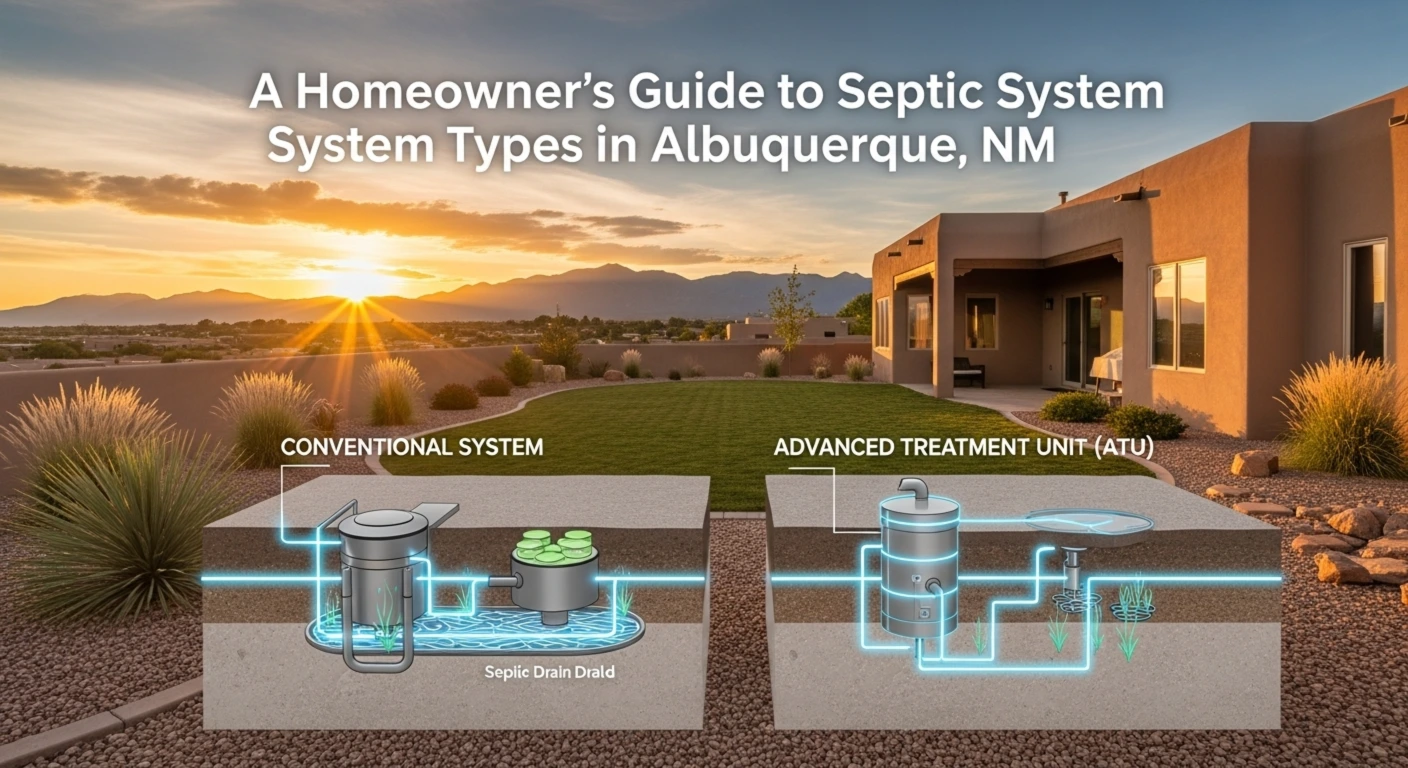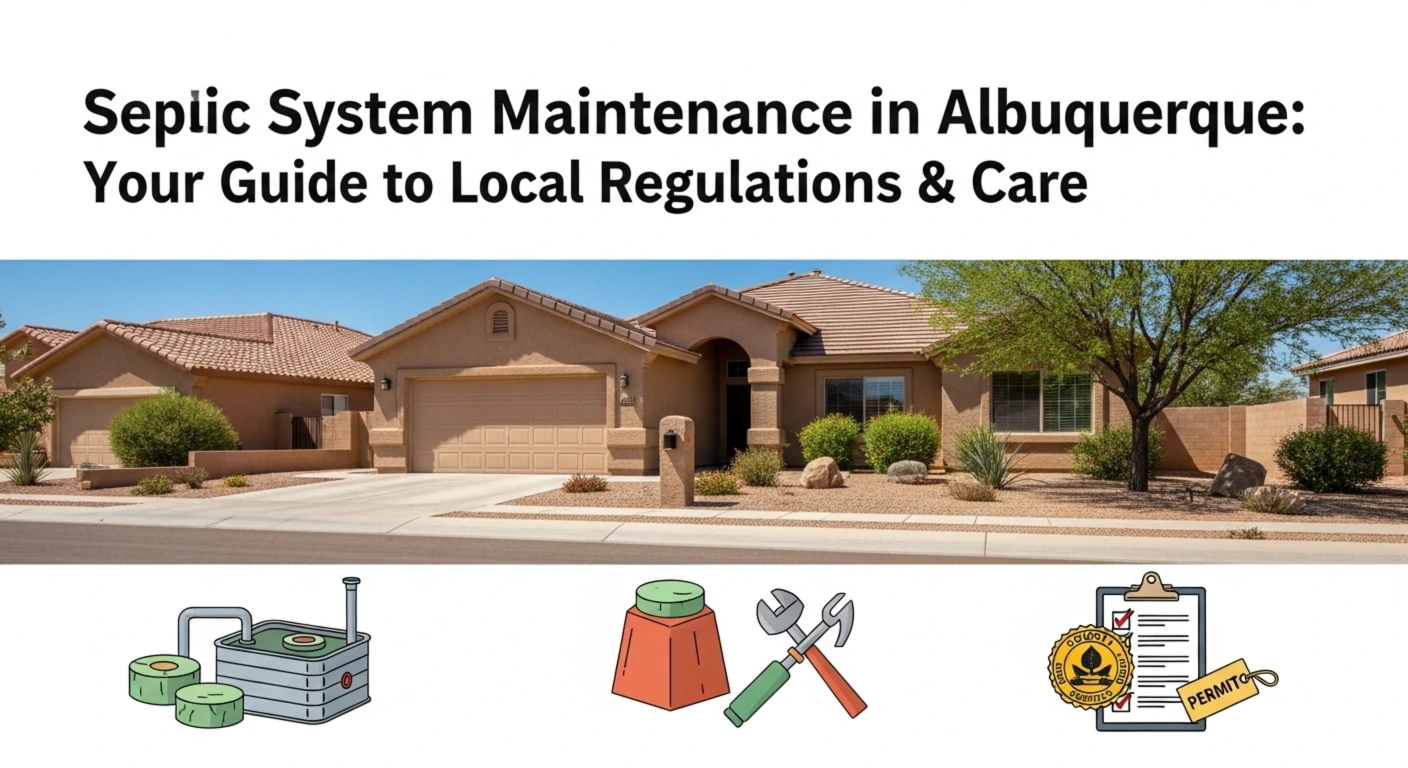For many residents in the communities surrounding Albuquerque from the high desert landscapes of the East Mountains to the river valleys of Corrales and the South Valley a septic system is an essential part of homeownership. Unlike properties connected to the city sewer, homes with septic systems have their own onsite wastewater treatment facility. Choosing, installing, or replacing one of these systems is a significant decision that directly impacts your property, your family’s well-being, and the local environment.
This guide aims to clarify the types of septic systems available to homeowners in Albuquerque and unincorporated Bernalillo County. It will explain how these systems operate, detail the specific classifications used by local authorities, and help you understand how our unique New Mexico environment influences the best choice for your property.
How a Septic System Works: The Two-Part Fundamentals
Before discussing the different types, it’s important to grasp the fundamental components of any septic system. At its core, a septic system involves a two-part process that uses natural and technological methods to treat wastewater from your home’s bathrooms, kitchen, and laundry.
The Septic Tank
This is a large, buried, watertight container, typically constructed from concrete or high-density plastic. All of your home’s wastewater flows into this tank. Inside, a natural separation process occurs. Heavy solids settle to the bottom to form a layer of sludge, while lighter fats, oils, and greases float to the top, forming a scum layer. Bacteria within the tank begin to break down the solid waste.
The Drainfield (or Leach Field)
After the solids have settled, the partially treated liquid wastewater, known as effluent, flows out of the tank and into the drainfield. The drainfield is a network of perforated pipes or chambers laid in underground trenches. This is where the final and most important stage of treatment takes place. The effluent slowly seeps out of the pipes and into the surrounding soil. The soil acts as a natural filter, where beneficial microorganisms remove harmful bacteria, viruses, and nutrients before the water eventually returns to the groundwater supply. The effectiveness of this final step highlights why understanding local soil conditions is absolutely vital.
Septic Systems 101: The Main Types You’ll Find in New Mexico
Based on guidelines from the Environmental Protection Agency (EPA) and the New Mexico Environment Department (NMED), several primary types of septic systems are used across the state. These form the basis for the specific systems approved for installation in the Albuquerque area.
Conventional System
This is the traditional design, consisting of a septic tank and a drainfield made of gravel- or stone-filled trenches. Effluent flows from the tank and is distributed through perforated pipes into the gravel, which allows for even dispersal into the soil below. While effective under the right conditions, these systems require a significant amount of space and are not suitable for all properties.
Chamber System
A more contemporary, gravelless alternative, the chamber system uses a series of connected, open-bottomed plastic chambers to create an underground void for the effluent. These systems are often simpler and quicker to install than traditional gravel systems and are particularly well-suited for areas where gravel is scarce or for properties with high water tables.
Drip Distribution System
This system uses a network of small-diameter tubing to slowly and evenly “drip” effluent over a large area. A key benefit is that the tubing is installed shallowly (6 to 12 inches deep), removing the need for a large mound of soil. However, these systems are more complex, requiring a dose tank, a pump, and electricity to operate, which adds to installation costs and maintenance needs.
Aerobic Treatment Unit (ATU)
An ATU is essentially a small-scale home sewage treatment plant. It uses an aerator to pump oxygen into the treatment tank, which promotes the growth of aerobic bacteria that are much more efficient at breaking down waste than the anaerobic bacteria in a standard septic tank. The effluent leaving an ATU is significantly cleaner. This makes ATUs an excellent solution for properties with small lots, poor soil conditions, high water tables, or those located near sensitive bodies of water.
The Local Law: Understanding Bernalillo County’s Official Septic System Classes
While the systems above are general types, it is important for local homeowners to understand that unincorporated Bernalillo County has its own wastewater ordinance that classifies systems based on their level of treatment. This classification determines what type of system is legally permitted for your specific property.
Conventional System (Class 1)
This classification refers to a standard septic system that provides primary treatment only essentially, a septic tank connected to a conventional drainfield. These systems are only permitted on properties with adequate lot size and suitable soil that can naturally handle the final treatment process effectively.
Secondary Systems (Class 2)
These systems provide a higher level of treatment. The most common type of Class 2 system is an Aerobic Treatment Unit (ATU). By adding oxygen, these systems significantly reduce contaminants like biological oxygen demand (BOD) before the effluent reaches the drainfield. A Class 2 system is often required by the county for properties with less-than-ideal soil conditions or smaller lot sizes.
Tertiary Systems (Class 3)
This is the highest level of treatment, designed for the most environmentally sensitive areas. In addition to the treatment provided by a Class 2 system, a Class 3 system also reduces nitrogen levels in the effluent through a process called denitrification. This is critical for protecting groundwater from nitrate contamination, especially in areas with shallow water tables.
The connection is straightforward but vital: The general system types you read about online directly correspond to the legal classifications in Bernalillo County. An ATU is a Class 2 system. A standard tank and drainfield is a Class 1 system. Understanding this helps you navigate the permitting process and ensure you install a system that is not only effective but also fully compliant with local law.
How Albuquerque’s Unique Environment Influences Your Septic Choice
The Bernalillo County Wastewater Ordinance explicitly states that the type of septic system you can install is determined by factors like lot size, site characteristics, and, most importantly, soil type. The diverse geography of the Albuquerque area from the rocky slopes of the East Mountains to the sandy mesas and clay-rich valley means there is no single solution that fits all properties.
Soil is Everything: Septic Solutions for Different Albuquerque Soils
A professional soil evaluation is a required step in the permitting process, as the soil’s ability to absorb and treat effluent is the most critical factor in a septic system’s success or failure.
Sandy and Gravelly Soils (Common on the West Mesa and parts of Rio Rancho)
It might seem that fast-draining soil is good, but for septic systems, it can be a challenge. If wastewater percolates through the soil too quickly, it doesn’t have enough contact time with the soil microbes for proper treatment, which can lead to groundwater contamination. For these areas, systems that provide a higher level of pre-treatment, such as an ATU (Class 2), or systems that control the rate of dispersal, like a drip distribution system, are often necessary to ensure effective filtration.
Clay and Loamy Clay Soils (Found in parts of the North Valley and East Mountains)
Clay soil presents the opposite challenge. Its dense, tightly packed particles drain very slowly, which can cause the drainfield to become saturated. When this happens, untreated effluent can surface in your yard or back up into your home. Conventional (Class 1) systems are often prohibited in heavy clay soils. The solution is typically an advanced system like an ATU (Class 2) that cleans the water more thoroughly before it enters the soil, or an engineered system like a mound system, which uses a raised bed of sand to create an artificial drainfield above the restrictive clay.
Special Considerations for the East Mountains vs. The Valley
The East Mountains (Tijeras, Cedar Crest, Sandia Park)
Properties in this area often face unique challenges such as steeper slopes, shallow soil depth to bedrock, and rocky or clay-heavy soil composition. These conditions frequently make conventional systems unsuitable and necessitate the use of more advanced, engineered systems (Class 2 or 3) to ensure proper wastewater treatment and prevent environmental degradation.
The North and South Valley
Homes in the valley, particularly those near the Rio Grande, may face issues with high water tables. A high water table reduces the amount of unsaturated soil available for treating effluent, increasing the risk of contamination. In these sensitive areas, a Class 3 system that reduces nitrogen may be required to protect the groundwater and the river ecosystem.
Comparing Albuquerque Septic Systems: A Quick-Reference Chart
To simplify your decision, this chart summarizes the key features of different septic systems in the context of the Albuquerque area.
| System Type | Bernalillo County Class | How It Works (Simplified) | Best For ABQ Area | Pros | Cons |
|---|---|---|---|---|---|
| Conventional | Class 1 | Gravity-fed trenches with gravel | Large, flat lots with deep, loamy soil | Lowest installation cost; simple design | Large footprint; unsuitable for poor soil or small lots |
| Chamber | Class 1 | Gravelless, open-bottom plastic chambers | Areas where gravel is scarce; good soil | Easier installation than conventional; uses recycled materials | Requires good soil; large footprint |
| ATU | Class 2 | Injects oxygen to accelerate waste breakdown | Small lots; poor clay or sandy soils; East Mountains | High treatment level; smaller drainfield | Requires electricity; regular maintenance is essential |
| Drip Distribution | Class 2 / 3 | Effluent is “dripped” into soil via tubing | Sloped lots; areas with shallow soil | Minimal site disruption; even distribution | Requires electricity and a pump; higher cost and maintenance |
| Mound System | Class 2 / 3 | Raised sand bed creates an artificial drainfield | Areas with clay soil, shallow bedrock, or high water table | Effective in very poor soil conditions | High installation cost; large visual impact on landscape |
Permitting and Installing a New System in Bernalillo County
Installing a new septic system in unincorporated Bernalillo County is a regulated process that requires professional oversight. The process involves submitting a detailed application to Bernalillo County Natural Resource Services, which must include a site plan and a soil evaluation. All work, from the initial site characterization to the final installation, must be performed by a contractor who is certified by the county. This ensures that the system is designed and installed correctly according to the specific conditions of your property and in full compliance with local health and environmental codes.
Call Albuquerque’s Septic Installation Experts
Choosing the right septic system is a significant investment in your property. The decision involves navigating complex local regulations and understanding the unique challenges of New Mexico’s soil and terrain. Our certified experts have years of experience designing and installing septic systems throughout the Albuquerque area, from the East Mountains to the Valley. We handle the entire process, from the initial site and soil evaluation to securing the necessary permits and completing a professional installation.
Contact us today for a free consultation and estimate to ensure you get the right system for your home.
Schedule Free Consultation



